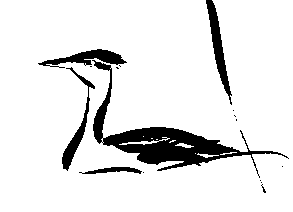|
Lake Hornborga
Background
Among the numerous lakes degraded through water level lowering in Sweden,
Lake Hornborga (in Swedish, Hornborgasjön, location 58°29'N, 13°34'E, Figure 1)
in the province of Västergötland, is the best known. This is partly because the
lowering was a legal scandal and a big economic failure, and partly because
extensive basic investigations have been made there, concerning the
possibilities to restore this type of shallow, drained lakes. The eco-technical
restoration methods elaborated at Lake Hornborga were applied there already in
the 1960s (Björk 1972).
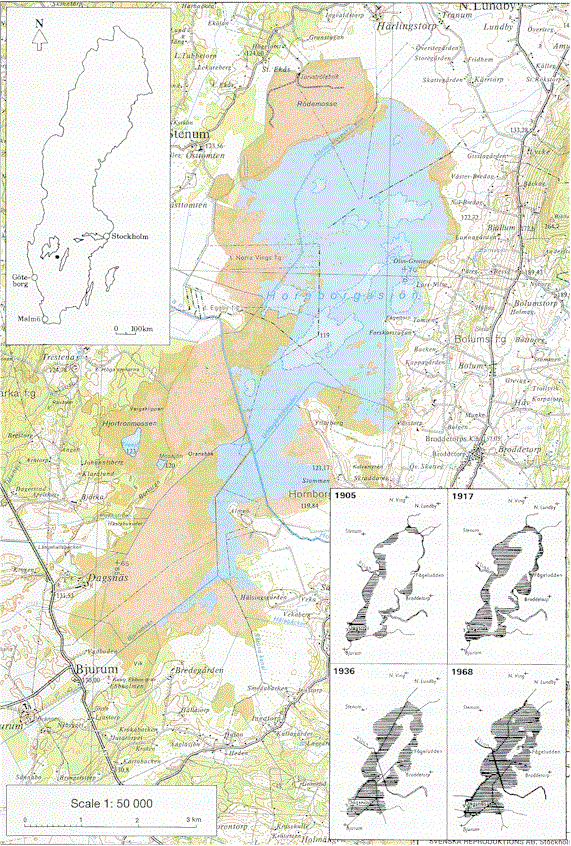
Figure 1. Lake Hornborga
Causes of degradation
Until man interfered with the well-organized complex of components that
functioned within the Lake Hornborga ecosystem, it maintained a rather high
degree of productivity without suffering from rapid ageing. This is quite
remarkable for a lake of this size (30 km2), shallowness and high
trophic level. The lake used to have a maximum depth of 3 metres, but most of
the lake was much shallower. A constellation of factors such as rapid water
renewal, well-situated inlets and outlets (Figure 1), strong water and strong
ice movements, provided a good system for transporting matter out of the lake
and prevented it from becoming overgrown. The emergent vegetation was mainly
restricted to wind-protected shore areas. The organic matter of the richly
developed submerged vegetation easily decayed and was transported out of the
lake, while the precipitated calcium carbonate particles covering these plants
settled to the bottom. Before degradation following the water level lowering and
finally, in 1933, complete drainage, Lake Hornborga ranked as one of the most
valuable lakes for waterfowl in northwestern Europe.
Since 1802, the lake has been lowered five times in attempts to obtain arable
land. The last big failure, in 1932-33, resulted in a bottom drained in the
summer, and which, in a considerable part of the lake, consisted of lake marl. A
hilly land area of about 616 km2 drains into the lake. This area
needs the Lake Hornborga as a reservoir to catch rainwater and melted snow that
rush down the hills to the plain below.
In 1954, the water level was slightly raised in the northern part (12 km2)
of the lake that was diked-in (Figure 1). This could be looked upon as a
large-scale field experiment. As described below, it revealed, amongst other
things, the necessity of removing the macrophytic vegetation and of restoring a
clean sediment bottom in areas intended to be re-created and preserved as open
water with submerged vegetation.
During the 1930s until the middle of the 1960s, the Hornborga area went
through the typical development for lowered, shallow lakes and their drained
surroundings. The lake area became overgrown by emergent vegetation. In fact,
the slight raising of the water level in 1954, to a maximum depth of c. 80 cm in
the diked-in portion, considerably improved the environmental conditions for
common reed which had colonized the lake bottom. Huge masses of coarse detritus
accumulated and filled in the lake basin (Figures 2 and 3). At the same time,
the surrounding organic soil areas subsided. Altogether this resulted in fairly
severe flooding and it became impossible to cultivate the successively wetter
organic soils.
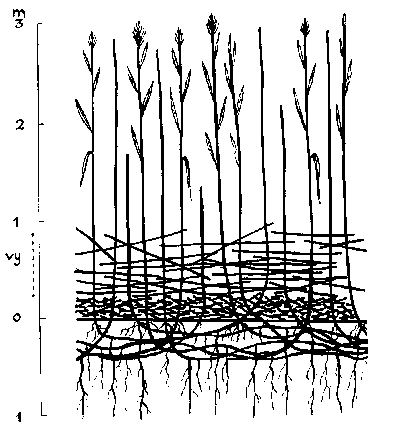 |
Vertical living stems and several generations of
dead stems
Horizontally deposited stems of several shoot generations together with
basal parts of broken stems
Very coarse Phragmites detritus
Roots and rhizomes |
Figure 2

|
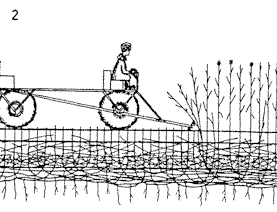
|
1. Initial state. The area
overgrown by common reed, the consolidated mud covered by coarse detritus and a
dense root felt developed in the top layer of the mud.
|
2. The work starts with
cutting during the winter. Capacity 2 hectares per hour. The reed material is
being burnt.
|
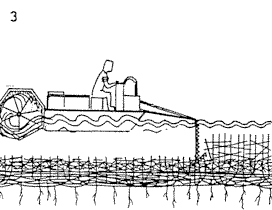
|
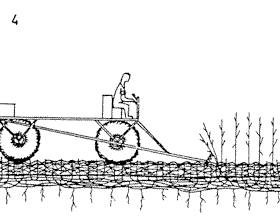
|
3. During the spring high water period pontoon-equipped mowing
machines are used for shortening the stubble and clearing the bottom from the
layer of horizontal reed stems.
|
4. At low water in the summer the green shoots are cut.
|
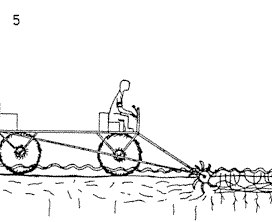
|
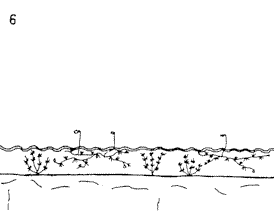
|
5. Final preparation of the bottom by a rotor cultivator.
|
6. Emergent
vegetation is replaced by submerged plants, and bottom fauna communities rich in
species and individuals are developed.
|
Figure 3. The Lake Hornborga restoration project.
Lake Hornborga lost its value as an outstanding waterfowl habitat because the
lake ecosystem's structure and function were completely destroyed. Monocultures
of common reed (Phragmites australis, Figure 8, upper left photo) and
slender-tufted sedge (Carex acuta), nearly covered the whole lake area in 1967.
Mixed plant communities including living and dead willow bushes (Salix spp.)
made large areas almost impenetrable.
Basic research, arguments and directives for restoration
The legal course of events, including the long series of illegal ingredients,
leading to the destruction of the great natural asset of Lake Hornborga, was
revealed by Swanberg (1959a, 1959b, 1968, 1971). He elucidated the very serious
economic and ecological consequences of the drainage project. Thanks to
Swanberg's basic research and persevering, convincing argumentation, it was
successively realized by all parties concerned that the drainage project was a
multidimensional failure that had severely hit both nature and culture. The
Swedish Government finally decided to investigate the possibilities to restore
Lake Hornborga. According to governmental directives, investigations to
determine whether or not the lake could still be restored and whether
restoration would be sufficiently permanent were to be carried out (Vilborg
1973). In the case that restoration would be theoretically possible, methods to
attain this goal were to be elaborated.
Restoration goals
The ecological goal for most restoration projects in lowered and overgrown
lakes is to create an open water area and a mosaic of open water and emergent/
submerged vegetation. The restored lake/wetland should be brought to a stage of
permanence where no future extensive management programme is needed. For
responsible, long-term planning of wetland restoration, management and
protection, this is of the utmost importance.
Shallow lake ecosystems are not at all static but highly dynamic systems and
can suffer from very rapid ageing processes. After water level lowering, as well
as after an insufficient increase in water levels as a means of ‘restoration’,
such lakes usually pass through a transient period of flourishing birdlife.
Sometimes, as in the Lake Hornborga case, it is still difficult to convince the
general public that this period is of just short duration and that ecologically
realistic measures to counteract the rapid ageing must be taken in order to give
the ecosystem sustainable character. When planning for restoration of such
systems to sustainable units – according to man's time-scale - it is necessary
to apply an holistic approach not only in space, i.e. to comprise the whole
ecosystem including its catchment area, but also in time, i.e. to allow for the
factors which have an influence on the speed of the ageing processes.
Field investigations
The field investigations started in 1967 and were carried out by a team of
ornithologists (under the leadership of Dr. P.O. Swanberg), limnologists,
technologists, hydrologists, economists and agriculturalists. In 1968, the lake
and its subsiding surrounding areas were mapped using aerial photographs to
obtain contour maps with a 25 m interval. Following the governmental directives,
the necessary limnological restorative measures and developmental prognoses were
elaborated, based on the specific conditions in the degraded Lake Hornborga
itself. As the ecological properties in every lake/wetland ecosystem are unique,
a tailor-made restoration plan has to be designed for each individual project.
One year of limnological studies made it quite clear - theoretically - that
Lake Hornborga could be restored (Björk 1972). The most serious problem
following the lowering of water levels in shallow lakes is the development of a
root-felt in the upper sediment layer and the accumulation of coarse plant
material (detritus) produced by highly productive macrophytic vegetation.
With clear evidence, the results of the limnological investigations
demonstrated that before the decisive step for the restoration of Lake Hornborga
- i.e. the raising of the water level - was to be taken, the bottom had to be
treated in order to get rid of the coarse plant material and the root-felt. In
1968, large-scale field experiments were begun in order to develop the technical
methods necessary to counteract the otherwise irreversible damage, i.e. the huge
masses of accumulated detritus as well as the root-felt of the emergent
macrophytes had to be removed (Figures 3, 4 and 5). If the water level is to be
raised over areas overgrown by sedge (Carex), reed (Phragmites), bulrush (Schoenoplectus)
etc., the gas (mainly methane) produced in the bottom accumulates in and beneath
the root-felt. After a period of time the root-felt would, therefore, float to
the surface and would soon be overgrown by new vegetation. This process leads to
plaur formation (floating stands of emergent macrophytes).
Project design
The basic limnological investigations carried out in all parts of Lake
Hornborga included both the inflowing streams and the outflow, and the
well-documented changes in the ecosystem following the drainage. Bottom levels,
sediment, peat, water and flora were studied and the results were synthesized
with findings from the groups responsible for ornithology, hydrology, etc. The
ecological restoration plan for Lake Hornborga was presented in 1973 (Plan/73,
cf. Björk 1972, Swanberg 1972, 1973, Vilborg 1973).
In Lake Hornborga, as elsewhere, the sedge root-felt poses a problem, as it
is thick, resistant and for economic reasons impossible to remove from the very
large areas covered by it (c. 18 km2). In small water bodies, the
floating root-felt can be removed by means of a dragline, or cut up, towed to
the shore and removed. The reed root-felt can easily be cut by amphibious
rotavators that were constructed for the Lake Hornborga project (Figure 4).
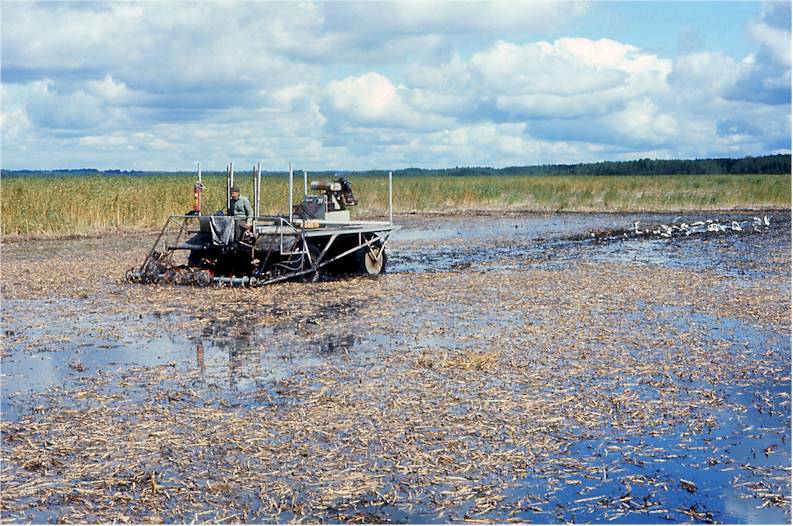
Figure 4. Lake Hornborga. Prototype of rotovator
for removal of the stubble mat and rhizome layer of Phragmites. The slowly
moving knives cut the rhizomes in long, easily-floating pieces.
Following the governmental directives, the limnological project goal for Lake
Hornborga was to transform the reed (Phragmites) areas to open water (about 11
km2) and to keep emergent vegetation in the area covered by sedge
(Carex) (about 18 km2). When the water level is raised, the sedge
root-felt will float to the water surface and be recolonised by reed
(Phragmites) and bulrush (Schoenoplectus). Before raising the water level, the
tough sedge root-felt can be removed from small areas by means of amphibious
excavators. After raising the water level these parts will be preserved as open
waters surrounded by plaur vegetation and attractive for birds.
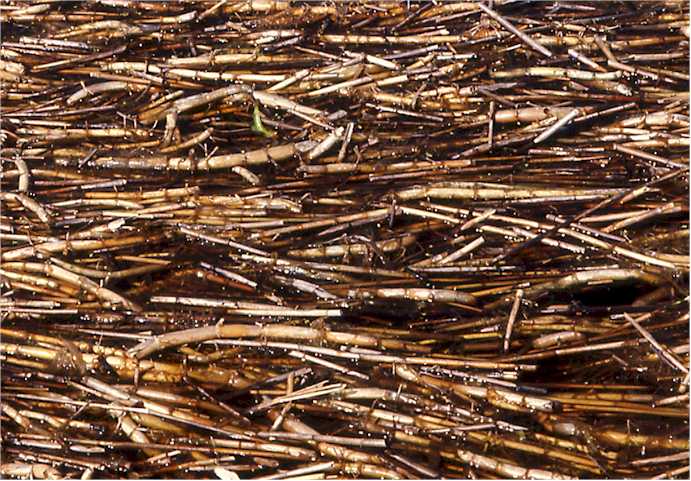
Figure 5. Lake Hornborga. Accumulation at the shore of
Phragmites rhizome pieces after cutting with rotovators. Björk 1969.
The procedure to replace emergent plant cover by submerged vegetation is
illustrated in Figure 3. During the field experiment in the years 1968-1972,
convincing results for a successful restoration using the above series of
methods were obtained. For cutting macrophytic vegetation and destroying the
root-felt, prototypes of amphibious and pontoon machines were developed. The use
of the constructed equipment is schematically shown in Figure 3, according to
dry and flooded conditions characteristic for the drained Lake Hornborga in the
1960s and 1970s. During dry periods in late summer and early autumn it was
sometimes possible to quickly clean several km2 from accumulated reed
detritus by means of fire (Figure 6), especially in the sections of the lake
where willow bushes prevented the immediate use of machines. However, the fire
does not destroy the root systems. Therefore, the productivity of the reed
becomes higher since the fire has improved the environmental conditions through
removal of the layers of settled detritus and dry stems which decrease both
temperature and light at the bottom.
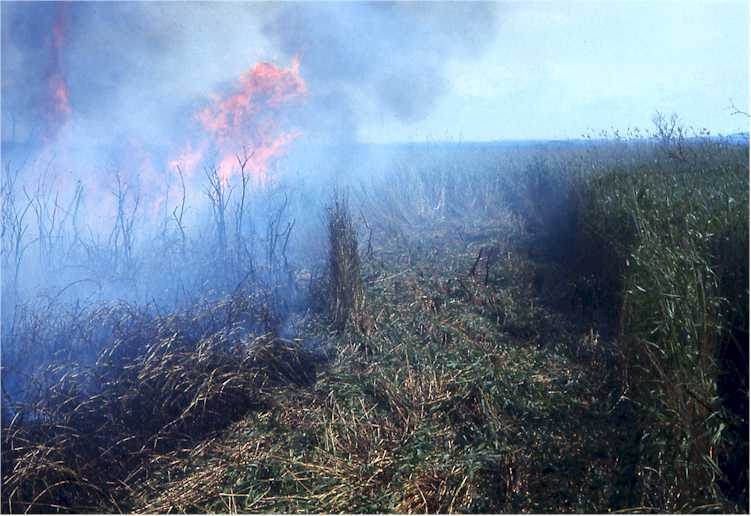
Figure 6. Lake Hornborga. Burning reed in late summer. Björk
1971.
It is usually most practical to start the removal of the macrophytic
vegetation along the wind-and wave-exposed shores. During periods of high water
level, the cut and loosened plant material is transported to the exposed shore.
During low water periods it is possible to burn it on the shore or to collect
and compost it. In small-scale projects, it is practical to carry out the
cutting and root destruction in sub-areas surrounded by floating booms. All the
loosened material is dragged within the boom to the shore and removed from the
lake by means of a conveyer belt. With the procedure as described in Figure 3,
enormous masses of coarse detritus deposited in the stubble mat was loosened and
together with the rhizomes and roots transported by the spring high water to the
shores along the wind-exposed portions of the lake where they were burned in the
summer.
When the detritus was removed, the consolidated original gyttja (mainly lake
marl) again became the bottom. If covered by sufficiently deep water, the reed
monoculture is replaced by submerged vegetation, and a rich bottom fauna,
microbenthos and periphyton develop. The biotope changes documented already
during the experimental period resulted in a very obvious improvement in the
waterfowl fauna (Figure 7).

|

|
1. Initial state. The area
overgrown by common reed, the consolidated mud covered by coarse detritus and a
dense root felt developed in the top layer of the mud.
|
Area: Ca 1 km2 finally prepared
|

Figure 7. Lake Hornborga before and after the demonstration
experiments for directing the production from emergent to submerged vegetation.
Water level not yet raised . Comparison between conditions in 1965. (Data from H
Berggren and PO Swanberg. From Björk 72)
The restoration of bottom areas primarily overgrown by common reed
(Phragmites) is an easy procedure by means of the technical equipment developed
for the Lake Hornborga project. Even if the root-felt of bulrush (Schoenoplectus)
and sedge (Carex) could be cut by rotavators, the main part of the loosened
material would remain on the bottom, stationary or partly drifting. In case of
common reed, the internodes of big pieces of stems and rhizomes are filled with
gas, providing them with excellent buoyancy (Figure 4, 5). It is imperative that
the rotavators cut the rhizomes in big pieces. Machines making slurry of both
stems and rhizomes are destructive because the buoyancy of the material gets
lost and the bottom is not cleaned but becomes covered by a layer of coarse,
partly drifting particles. Methane gas develops in the degradation process of
the organic matter prepared in that way.
After treatment of 11 km2 of the bottom as described, and manual
removal of trees and especially bushes along the shores and in the bays of the
former lake, the restoration plan presented in 1973 (Plan/73) recommended the
raising of the water level in two steps, first by c. 1 m and then, after about 5
to 10 years by a further 0.5 m. This procedure was recommended in order to get
the wind-exposed shores worked up, cleaned and washed by the waves in a natural
way. The primary raising of the water level should be sudden and big enough to
prevent both successive recolonization of emergent species, mainly Phragmites,
from the littoral zone and survival of initial stands in open shallow water
areas. Before the lake degraded completely, Schoenoplectus was the
characteristic species. After a restoration according to Plan/73, this species
would again develop outside Phragmites stands along the shores and within plaur
areas. With the distribution of the emergent vegetation under control by means
of water depth, wave and especially ice action, the sediment bottom cleaned from
coarse detritus could be largely covered by underwater vegetation (Figure 8
middle row left).
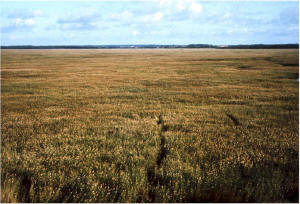
|
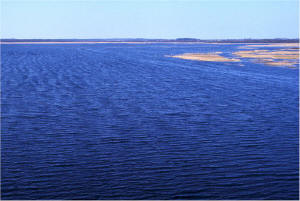
|
1967. Initial state.
|
1970. Treated area. reed stems cut and removed
|

|
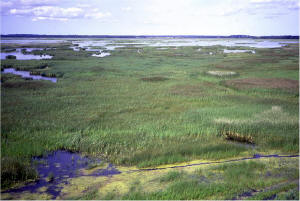
|
1973. After cutting the reed, coarse detritus, stubble
rhizomes and root-felt have been cleaned from the bottom
|
1989. Without raising the water level the treated area is recolonised by Schoenoplectus, Phragmites and Typha.
|

|
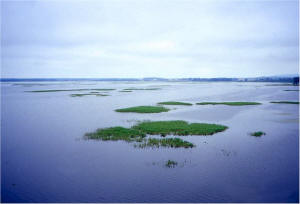
|
1997 after raising the water by 80 cm.
|
2002 Reduction of the emergent vegetation partly as a
result of grazing by geese.
|
Figure 8. Lake Hornborga. Demonstration of restoration methods
and recolonisation of treated areas. Sven Björk.
According to Plan/73 lowland areas adjacent to Lake Hornborga should not be
cut off from the restored lake as shallow shores and vast wetlands also belonged
to the most characteristic features of the former lake (Vilborg 1973). Plan/73
recommended the construction of 1) the compulsory dike at the outlet for making
it possible to raise and regulate the water level and, in addition to that 2)
short dikes for protection of still arable land against high-water floods, part
of these landwards from large plaur areas (Figure 9).

|
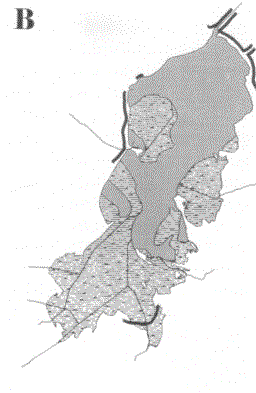
|
Plan /73
|
Plan/76
|

|
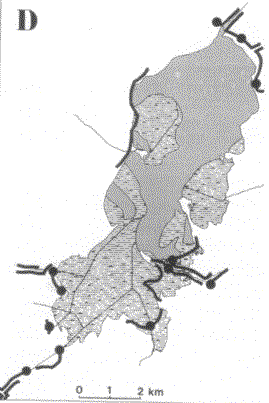
|
Demands by the county agricultural board
|
Plan /80-81 including 12 pumping stations to ensure sustainable
farming
Plan /83-84 includes dikes according to Plan /80-81and raising of the
lake level by at first ca 80 cm and - in case the dikes prove to be tight
- by further 55 cm
According to Plan /86-87the rise was first reduced to only c 80 cm and
dikes för protection of agricultural land reduced to the Härlingtorp-
Tranum area.
|
Figure 9. The extent of dikes according to plans and demands
Project Implementation
In 1977, the limnological restoration plan of 1973 was unanimously accepted
by the Riksdag (Parliament) and in 1982, the Water Court and the Government
granted permission to raise the water level, in two steps, by 1.4 m. The Swedish
Environmental Agency was responsible for the implementation of the plan. However,
under their management, dikes, finally reaching a total length of 25 km, were
projected around the lake and along tributaries. In addition to these, efforts
were also made to get permission for construction of the Hertzman dike for
reclamation of one of the lake's broad bays (Figure 9). The latter was, however,
rejected by the Government. Because geological investigations had not been made
at the suggested location of the dikes, the risks for leakage had not been
assessed. Pleading the argument that depths greater than 0.4 m is a waste of
water with regard to the environmental demands of many duck species, together
with that of the leakage risks, the Environmental Agency changed the plan for
the restoration of Lake Hornborga. The projected dikes (with the exception of
the one at the outlet) were abolished and the water was to be raised by only c.
0.8 m, with the first water rise by 0.2 m in 1992.
An overview of the treatment of Lake Hornborga after shrinking Plan/73 was in
1999 presented by Hertzman and Larsson. They argue that “the technical planning
and the presentation of the restoration measures were formulated before the
ecological implications of the suggested steps were fully analysed” and that
“the prevailing idea” was “that if the limnological aspects were adequately
addressed, the necessary ecological conditions for the birds would more or less
automatically be created” (op.c. p. 68). Their plan, however, was not equipped
with any environmental impact assessment (EIA).
In accordance with the limnological prognoses given in Plan/73, plaur
formation (root felt of Carex, etc., because of methane accumulation loosened
from the bottom, and coming to the surface) soon started (Figure 10) after the
rise in water level and ice movements occurred. The bird life has improved
considerably. Incorrectly treated bottom areas are characterized by intense
production of methane (Figure 11).
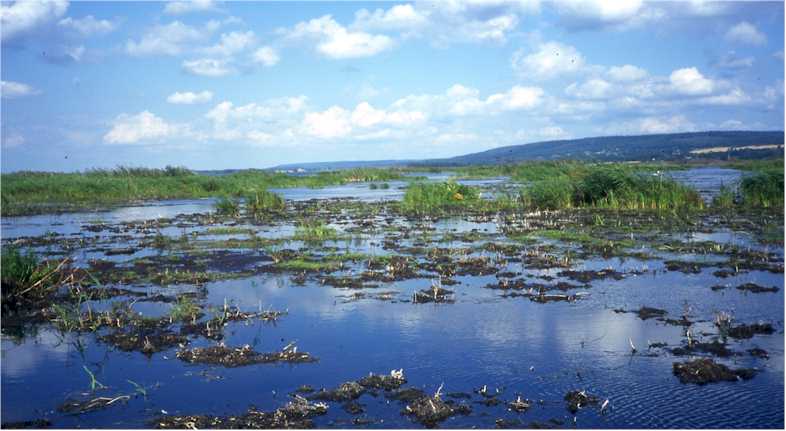
Figure 10. Plaur formation in the bay Västorpaviken, in the drained lake overgrown by Carex
acuta. Björk 2000.
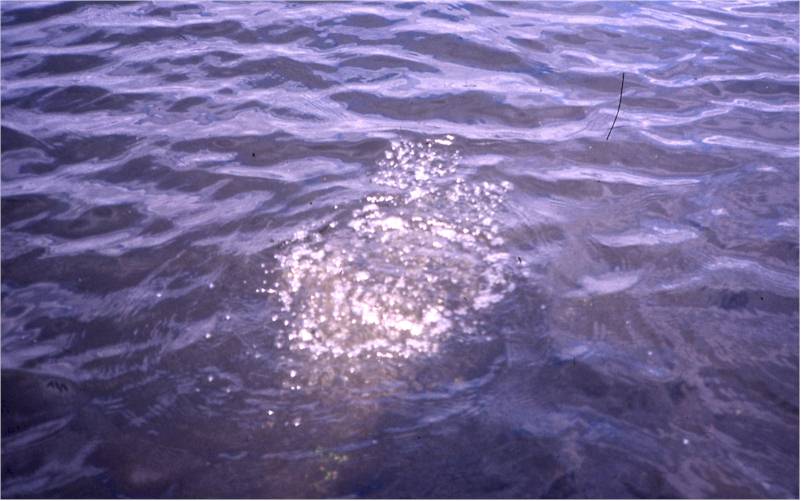
Figure 11. Ebullition of methane produed in a bottom
treated with machines making a slurry of gyttja and living sedge. Björk 1998.
Unforeseen has been the strong increase in the number of greylag geese (Anser
anser) efficiently consuming reed-bed plants. The striking reduction of
Phragmites has forced more than 75 % of the marsh harriers (Circus aeruginosus)
to breed in Salix bushes instead of in reed-beds. In 2001 a total of 36 breeding
pairs were recorded at the lake (Pettersson 2002).
The future development of the ecosystem will serve as an illustrative example
of the importance in restorative planning of a holistic view in both space and
time. The further the ageing processes (filling in with sediment, peat and
coarse detritus) have advanced in shallow lake basins, the more difficult it is
to restore them by raising the water level. Ultimately, it becomes impossible.
If the lake should be restored in a sustainable way, then that part not covered
by revegetated plaur and bottom-rooted emergent plants must be large and deep
enough to give the ecosystem the functional longevity as stressed in the
original governmental directives for a restoration of Lake Hornborga, and not
just give it a temporary appearance as an attractive waterfowl habitat. The open
water should act as the 'heart and kidney' of the whole area, constituting an
integrated part of the complex system, functionally powerful enough to preserve
the vitality after restoration. Persistence of the results would, otherwise, be
a matter of decades, not centuries. Every rise in the water level would, of
course, cause a flourishing period for waterfowl, but the lower the rise the
shorter the period.
It must not be forgotten that even a limnologically correctly restored Lake
Hornborga is severely damaged by the former water level lowering and that the
restored system must be given a structural and functional capacity to withstand
the increased nutrient loading. It should, amongst other things, have the
capacity to metabolise nutrient-rich water from the agricultural catchment area
(the 1954 diked-in lake was supplied with such water for only a short spring
period) as well as anoxic water pressed out from the plaur sections during
periods of decreasing water level. In this connection, chain reactions,
including periodic oxygen deficiency and nutrient release, will appear and will
affect animal survival and fertilisation of downstream waters. Within the open
water area, the bottom should consist of sediment cleaned from root-felt and
coarse detritus. Furthermore, the open water should be large enough to enable
the formation of blue ice capable of pressing and pushing to keep exposed shores
open as the ice did in the lake before its degradation.
The evolution of shallow lakes/wetlands is, in several respects dependent on
the conditions in the extreme years. Most important are the effects of dry
periods with low water levels, especially if these effects in regulated lakes
cannot be compensated by the effects of extreme high water periods. In dry years,
the artificially shallow lake overgrown by emergent vegetation will suffer from
extra water losses due to intensive transpiration from the plant cover. Within
the dry littoral zone, plants will transpire groundwater which, otherwise, would
have supplied the lake. In addition to this, agricultural irrigation may reduce
the supply of water during dry seasons. The summarising effect of low water
level in extreme years is a lakeward expansion of emergent macrophytic
vegetation, resulting in increased production of accumulating coarse detritus.
The Plan/73 for the restoration of Lake Hornborga also included measures to
secure an even bottom in order to prevent sites from the accumulation of
detritus and development of stands of emergent plants. Dikes along the drainage
canals (Figure 1) had, therefore, to be levelled as part of the efforts to
restore, as much as possible, the former wind-induced regime for in-lake water
and ice movements.
Methods to increase water depth
When the water depth of a lake becomes too shallow, there are in general
three possibilities to increase it: to raise the water level, to lower the
bottom, or to combine these two measures. Under all circumstances the bottom has
to be treated in order to get rid of the accumulated coarse plant material and
the root-felt, a procedure which also results in a lowering of the bottom level.
In Lake Hornborga, the removal of the root-felt and the dense stubble mat
according to the Plan/73 would have lowered the bottom by c. 40 cm.
Lake Hornborga is situated in an area where the bedrock, in some parts,
consists of limestone. The characteristic sediment deposit in the northem
section of the lake is lake marl, i.e. calcium carbonate precipitated as a
result of the photosynthetic activity of a rich submersed vegetation. The marl
is of high quality and excellent for the liming of acidified areas instead of
spreading finely-ground limestone/chalk, obtained from quarries, and crushed and
ground to fine fractions. In Sweden, where inland waters in oligotrophic areas
are suffering from acidification, the liming of acidified lakes, brooks and
catchment areas is state-financed (c. US$11 million per year in the middle of
the 1980s).
In lowered and completely drained lakes with lake marl as the characteristic
sediment, modern automatic extraction methods have opened up possibilities for
efficient sediment-mining aimed at the restoration of the lowered lakes, and the
treatment of acidified land and waters. For Lake Hornborga, situated on the
geological borderline between limestone and gneiss, lake marl is a
characteristic sediment (Figure 12), and immediately southwest of the lake is
the area of Sweden where the soils and waters are most severely affected by
acidification. At the start of the Hornborga project, in the mid-1960s,
acidification was not yet identified as an environmental problem and large-scale
liming as a remedial measure was, of course, not introduced until later.
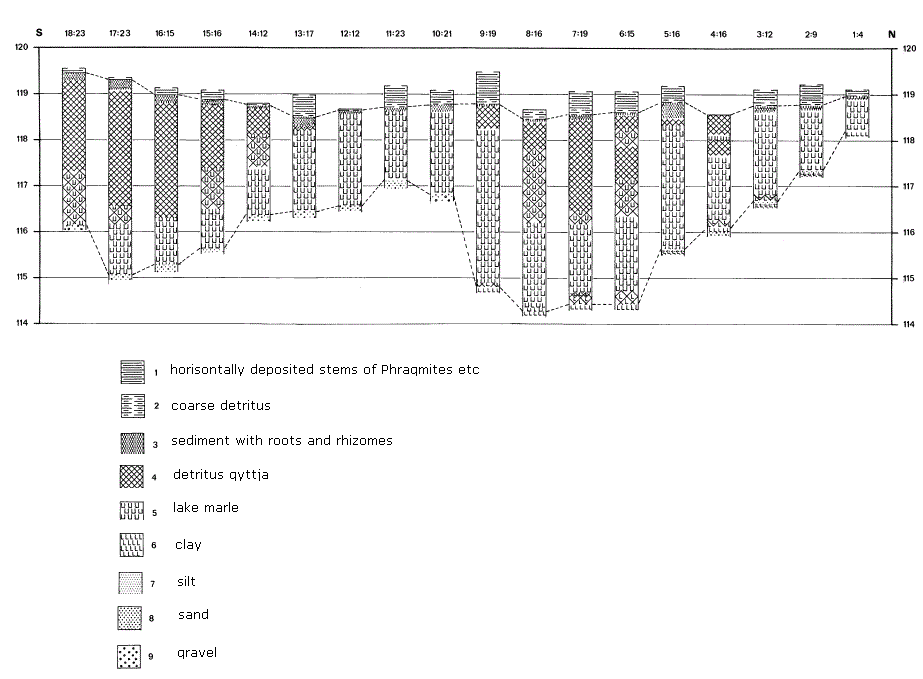
Figure 12. Lake Hornborga. Stratigrafical section from north
(N) to south (S). Figures on both sides of the diagram level above the sea (m).
The upper dashed line connects the upper levels för consolidated gyttja and the
lower line the upper levels for minerogenic soils.
As pointed out at the beginning of this chapter, the ageing of shallow,
productive lowland lakes is caused by the deposition of sediment and peat,
produced in the ecosystem. In Lake Hornborga, the sediment in that part of the
lake possible to restore to open water, consists of thick, homogeneous deposits
of high-quality lake marl. The removal of the top layer of marl would not have
changed the character of the bottom. The increase in water depth, would, on the
contrary, have had a real rejuvenating effect on the system. Thus, after liming
had been given such a high economic priority in environmental protection
financed by the state, there would have been an excellent opportunity to
investigate this innovative alternative for reaching the goal of a sustainable
Lake Hornborga through the combination of lowering the bottom and raising the
water level, although this possibility did not appear until after half-time in
the protracted project. Within the lake and wetland restoration-research sector
there is an urgent need for the collection of experience of ecologically
realistic, and economically sound, methods applied in demonstration projects.
References
Björk, S. (1972). Statens naturvårdsverks utredning beträffande
Hornborgasjöns framtid. Den limnologiska delutredningen. Förutsättningar,
metoder och kostnader for Hornborgasjöns restaurering. (The national
environmental protection agency's investigation concerning the future of Lake
Hornborga. The limnological investigation. Conditions, methods and costs.).
Statens narurvårdsverk, Stockholm, PM 280. (2nd ed. 1978). 55pp. (In
Swedish.)
Hertzman, T. & Larsson, T. (1999). Lake Hornborga, Sweden – the return of a bird
lake. Wetlands Internat. Publ., 82 pp.
Pettersson, B. (2002). Härrhökars boplatsval I Hornborgasjön före och efter
restaureringen. (Harriers’ choice of nesting sites in Lake Hornborga before and
after restoration.) Vår fågelvärld, 2, 24-25.
Swanberg, P.O. (1959a). Hornborgasjön som fågelsjö. (Lake Hornborga as a
waterfowl lake). Från Falbygd till Vänerkust. Lidköping. (In Swedish.)
Swanberg, P.O. (1959b). Hornborgasjöns sänkningar. (The lowerings of Lake
Hornborga). Från Falbygd till Vänerkust. Lidköping. pp. 132-151. (In Swedish.)
Swanberg, P.O. (1968). Hornborgasjön och människan. (Lake Hornborga and man.)
Falbygden, 22, 175-206. Falköping. (In Swedish.)
Swanberg, P.O. (1971). Hornborgasjön. (Lake Hornborga). Boken om Gudhem (ed. H.
Johansson). Falköping. pp. 274-303. (In Swedish.)
Swanberg, P.O. (1972). Metodik i den ornitologiska inventeringen av
Hornborgasjön 1969-1971. (Methods used in the ornithological census of Lake
Hornborgasjön in 1969-1971). Vår Fågelvärld, 39, 369-376. (In Swedish with
English summary.)
Swanberg, P.O. (1973). Hornborgasjön som fågelsjö. Ornitologisk undersökning i
statens naturvårdsverks utredning om sjöns framtid. (Lake Hornborga as a
waterfowl lake. The ornithological study of the national environmental
protection agency's investigation concerning the future of Lake Hornborga.
Statens naturvårdsverk, Stockholm, P.M. 280. (2nd ed. 1978) 100pp. (In Swedish.)
Vilborg, L. (1973). Hornborgasjönutredningen. (The Lake Hornborga investigation.).
Statens naturvårdsverk, Stockholm, PM 280. 34pp. (In Swedish.)
Summary by Sven Björk in: Martina Eiseltova (editor). 2010. Restoration of
Lakes, Streams, Floodplains, and Bogs in Europe. Springer. 374 pp.
|
 Restoration of Lake Hornborga-2017
Restoration of Lake Hornborga-2017
